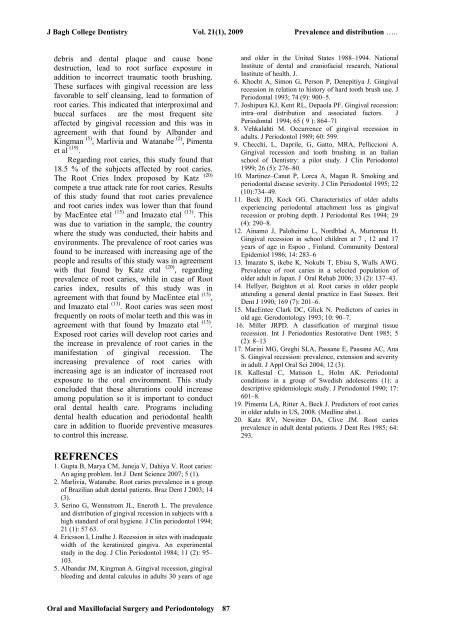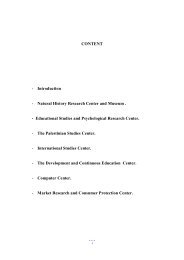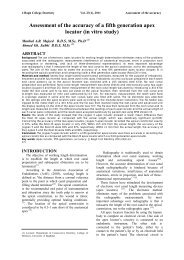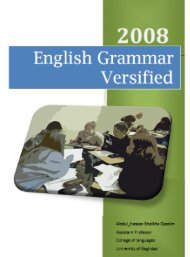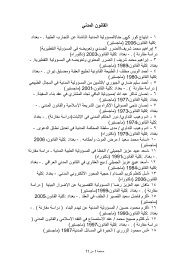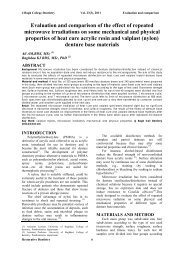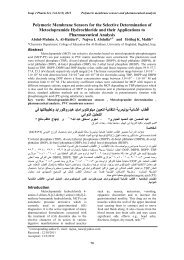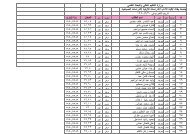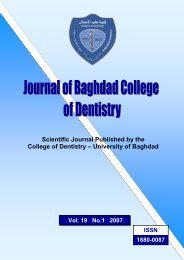Vol 21 No. 1
Vol 21 No. 1
Vol 21 No. 1
You also want an ePaper? Increase the reach of your titles
YUMPU automatically turns print PDFs into web optimized ePapers that Google loves.
J Bagh College Dentistry <strong>Vol</strong>. <strong>21</strong>(1), 2009 Prevalence and distribution …..<br />
debris and dental plaque and cause bone<br />
destruction, lead to root surface exposure in<br />
addition to incorrect traumatic tooth brushing.<br />
These surfaces with gingival recession are less<br />
favorable to self cleansing, lead to formation of<br />
root caries. This indicated that interproximal and<br />
buccal surfaces are the most frequent site<br />
affected by gingival recession and this was in<br />
agreement with that found by Albander and<br />
Kingman (5) , Marlivia and Watanabe (2) , Pimenta<br />
et al (19) .<br />
Regarding root caries, this study found that<br />
18.5 % of the subjects affected by root caries.<br />
The Root Cries Index proposed by Katz (20)<br />
compete a true attack rate for root caries. Results<br />
of this study found that root caries prevalence<br />
and root caries index was lower than that found<br />
by MacEntee etal (15) and Imazato etal (13) . This<br />
was due to variation in the sample, the country<br />
where the study was conducted, their habits and<br />
environments. The prevalence of root caries was<br />
found to be increased with increasing age of the<br />
people and results of this study was in agreement<br />
with that found by Katz etal<br />
(20) , regarding<br />
prevalence of root caries, while in case of Root<br />
caries index, results of this study was in<br />
agreement with that found by MacEntee etal (15) ,<br />
and Imazato etal (13) . Root caries was seen most<br />
frequently on roots of molar teeth and this was in<br />
agreement with that found by Imazato etal (13) .<br />
Exposed root caries will develop root caries and<br />
the increase in prevalence of root caries in the<br />
manifestation of gingival recession. The<br />
increasing prevalence of root caries with<br />
increasing age is an indicator of increased root<br />
exposure to the oral environment. This study<br />
concluded that these alterations could increase<br />
among population so it is important to conduct<br />
oral dental health care. Programs including<br />
dental health education and periodontal health<br />
care in addition to fluoride preventive measures<br />
to control this increase.<br />
and older in the United States 1988–1994. National<br />
Institute of dental and craniofacial research, National<br />
Institute of health. J.<br />
6. Khocht A, Simon G, Person P, Denepitiya J. Gingival<br />
recession in relation to history of hard tooth brush use. J<br />
Periodontal 1993; 74 (9): 900–5.<br />
7. Joshipura KJ, Kent RL, Depaola PF. Gingival recession:<br />
intra–oral distribution and associated factors. J<br />
Periodontal 1994; 65 ( 9 ): 864–71<br />
8. Vehkalahti M. Occurrence of gingival recession in<br />
adults. J Periodontol 1989; 60: 599.<br />
9. Checchi, L, Daprile, G, Gatto, MRA, Pelliccioni A.<br />
Gingival recession and tooth brushing in an Italian<br />
school of Dentistry: a pilot study. J Clin Periodontol<br />
1999; 26 (5): 276–80.<br />
10. Martinez–Canut P, Lorca A, Magan R. Smoking and<br />
periodontal disease severity. J Clin Periodontol 1995; 22<br />
(10):734–49.<br />
11. Beck JD, Kock GG. Characteristics of older adults<br />
experiencing periodontal attachment loss as gingival<br />
recession or probing depth. J Periodontal Res 1994; 29<br />
(4): 290–8.<br />
12. Ainamo J, Paloheimo L, <strong>No</strong>rdblad A, Murtomaa H.<br />
Gingival recession in school children at 7 , 12 and 17<br />
years of age in Espoo , Finland. Community Dentoral<br />
Epidemiol 1986; 14: 283–6<br />
13. Imazato S, ikebe K, <strong>No</strong>kubi T, Ebisu S, Walls AWG.<br />
Prevalence of root caries in a selected population of<br />
older adult in Japan. J Oral Rehab 2006; 33 (2): 137–43.<br />
14. Hellyer, Beighton et al. Root caries in older people<br />
attending a general dental practice in East Sussex. Brit<br />
Dent J 1990; 169 (7): 201–6.<br />
15. MacEntee Clark DC, Glick N. Predictors of caries in<br />
old age. Gerodontology 1993; 10: 90–7.<br />
16. Miller JRPD. A classification of marginal tissue<br />
recession. Int J Periodontics Restorative Dent 1985; 5<br />
(2): 8–13<br />
17. Marini MG, Greghi SLA, Passane E, Passane AC, Ana<br />
S. Gingival recession: prevalence, extension and severity<br />
in adult. J Appl Oral Sci 2004; 12 (3).<br />
18. Kallestal C, Matsson L, Holm AK. Periodontal<br />
conditions in a group of Swedish adolescents (1): a<br />
descriptive epidemiologic study. J Periodontol 1990; 17:<br />
601–8.<br />
19. Pimenta LA, Ritter A, Beck J. Predictors of root caries<br />
in older adults in US, 2008. (Medline abst.).<br />
20. Katz RV, Newitter DA, Clive JM. Root caries<br />
prevalence in adult dental patients. J Dent Res 1985; 64:<br />
293.<br />
REFRENCES<br />
1. Gupta B, Marya CM, Juneja V, Dahiya V. Root caries:<br />
An aging problem. Int J Dent Science 2007; 5 (1).<br />
2. Marlivia, Watanabe. Root caries prevalence in a group<br />
of Brazilian adult dental patients. Braz Dent J 2003; 14<br />
(3).<br />
3. Serino G, Wennstrom JL, Eneroth L. The prevalence<br />
and distribution of gingival recession in subjects with a<br />
high standard of oral hygiene. J Clin periodontol 1994;<br />
<strong>21</strong> (1): 57 63.<br />
4. Ericsson I, Lindhe J. Recession in sites with inadequate<br />
width of the keratinized gingiva. An experimental<br />
study in the dog. J Clin Periodontol 1984; 11 (2): 95–<br />
103.<br />
5. Albandar JM, Kingman A. Gingival recession, gingival<br />
bleeding and dental calculus in adults 30 years of age<br />
Oral and Maxillofacial Surgery and Periodontology 87


